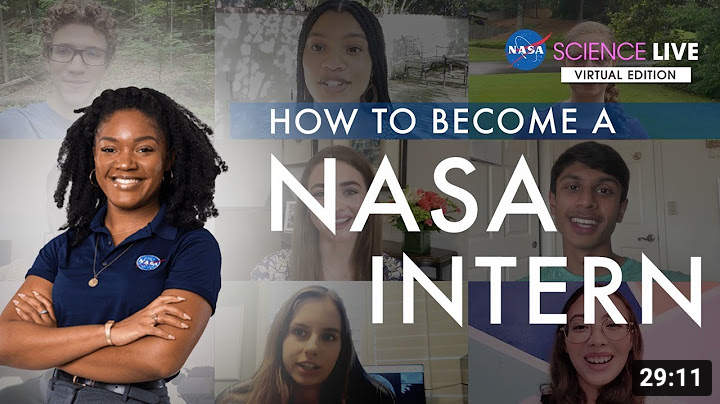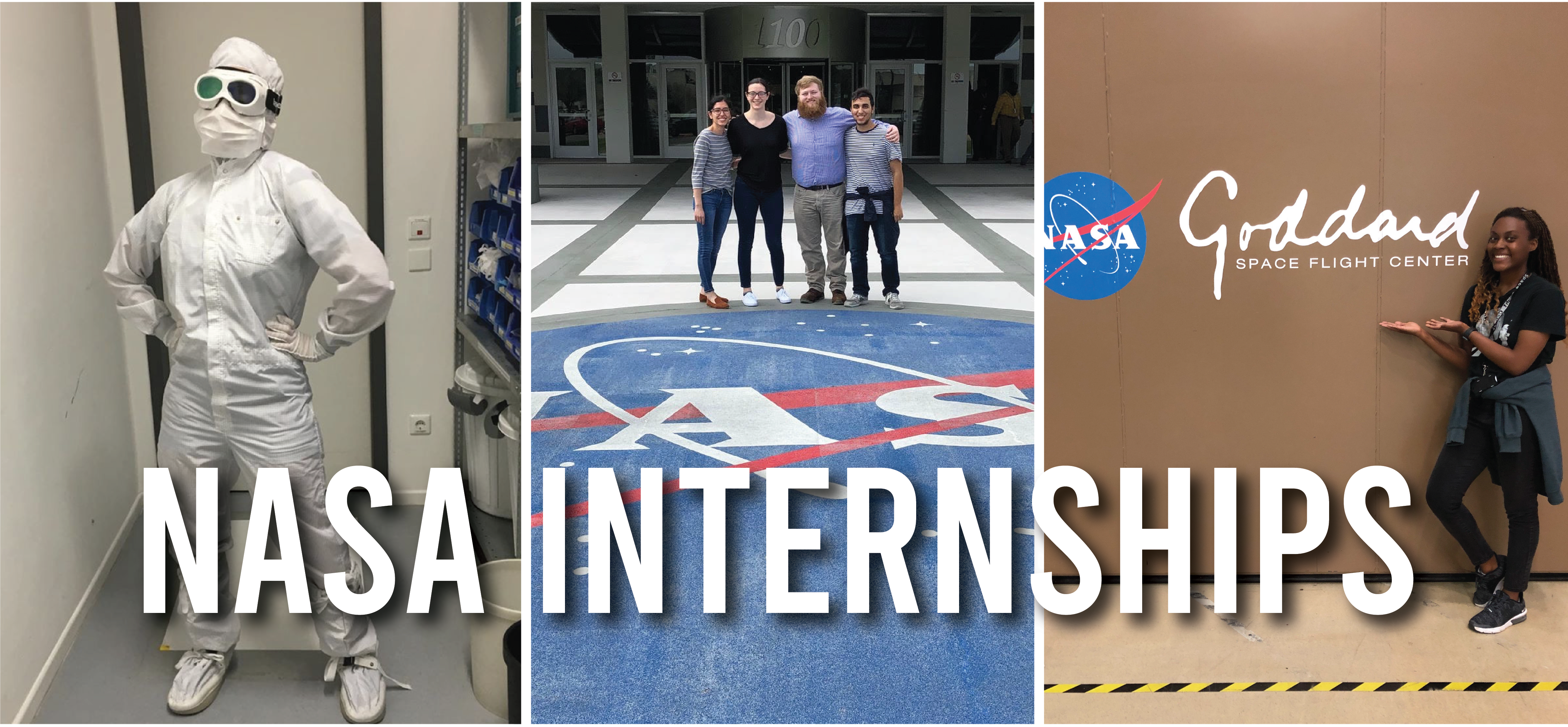NASA Center Internships
 NASA Internships are educational hands-on opportunities that provide unique NASA-related research and operational experiences for high school, undergraduate, and graduate students as well as educators. These internships integrate participants with career professionals emphasizing mentor-directed, degree-related, real-time world task completion. During the internship participants engage in scientific or engineering research, development, and operations activities. In addition, there are non-technical internship opportunities to engage in professional activities which support NASA business and administrative processes. Through these internships, participants leverage NASA’s unique mission activities and mentorship to enhance and increase their professional capabilities and clarify their long-term career goals.
NASA Internships are educational hands-on opportunities that provide unique NASA-related research and operational experiences for high school, undergraduate, and graduate students as well as educators. These internships integrate participants with career professionals emphasizing mentor-directed, degree-related, real-time world task completion. During the internship participants engage in scientific or engineering research, development, and operations activities. In addition, there are non-technical internship opportunities to engage in professional activities which support NASA business and administrative processes. Through these internships, participants leverage NASA’s unique mission activities and mentorship to enhance and increase their professional capabilities and clarify their long-term career goals.
NASA Internships can be full or part-time, conducted at a NASA facility, contractor facility, or anywhere activities are ongoing to advance NASA’s missions. Mentors can be civil servants, contractors, or faculty conducting activities directly related to NASA’s unique assets and ongoing mission activities.
NASA internships occur within the following 4 sessions per year generally corresponding to the academic calendar: spring, summer, fall, and year-long (often following the academic year August-May)
NASA Centers:
- Neil A. Armstrong Test Facility – Sandusky, Ohio
- Glenn Research Center – Cleveland, Ohio
- Goddard Institute for Space Studies – New York, New York
- Goddard Space Flight Center – Greenbelt, Maryland
- Mary W. Jackson NASA HQ – Washington D.C.
- Wallops Flight Facility – Wallops Island, VA
- Langley Research Center – Hampton, VA
- Katherine Johnson IV & V Facility – Fairmont, West Virginia
- Kennedy Space Center – Merritt Island, Florida
- Marshall Space Flight Center – Huntsville, Alabama
- Stennis Space Center – Hancock County, Mississippi
- Johnson Space Center – Houston, Texas
- White Sands Test Facility – Las Cruces, New Mexico
- Armstrong Flight Research Center – Edwards Air Force Base, California
- Jet Propulsion Laboratory – Pasadena, California
- Ames Research Center – Mountain View, California
- Vandenberg Space Force Base – Lompoc, California
MSGC strongly encourages you to apply early. Some NASA internships are funded within the centers themselves; others require outside funding through Space Grant Consortia. Students who are funded at NASA Centers through MSGC will need to provide a report within 30 days after the end of their internship and will be expected to make a presentation about their experience – either a poster or a talk – at the MSGC Fall Conference following their internship. Reporting requirements are linked below.
Eligibility at a Glance
| Requirements | OSTEM Intern | Pathways Intern | International Intern |
| Citizenship | U.S. Citizen | U.S. Citizen | Citizen of a country with a current agreement |
| GPA | 3.0 on a 4.0 scale | 2.9 on a 4.0 scale | Maintain high academic standing |
| Enrollment | Be a full-time student (high school through graduate-level) or a part-time college-level student enrolled in a minimum of 6 semester hours. Current educator |
A degree or certificate seeking student who is currently enrolled or accepted for enrollment in an accredited educational institution on at least a half time basis Have completed at least 15 semester hours or 23 quarter hours Be able to work at least 480 hours before completing degree/certificate requirements |
Pursuing an undergraduate or graduate degree in science, technology, engineering or mathematics (STEM) in a topic relevant to NASA’s mission priorities |
| Other | Must be 16 years old at time of application | At least 16 years old at the time of appointment | Demonstrate an active interest in the U.S. space program Communicate proficiently in English |
A common misconception is that NASA only offers engineering internships. Please know that we have opportunities for students who are not majoring in engineering. NASA needs employees with a variety of knowledge and skills. At NASA, our engineers, mathematicians, scientists, accountants, writers, IT specialists, project managers, program analysts, and many other professionals work together to break barriers to achieve the seemingly impossible. Non-engineering interns may support a variety of business and program management work, including procurement, budgeting, accounting, information technology, and security.
International student? If you are a citizen of one of the countries listed below, and are interested in applying to one of the available research opportunities, please contact the entity in your country currently participating in NASA’s International Internship (I2) program.
- Australia: Victorian Space Science Education Center (VSSEC)
- Brazil: Brazilian Space Agency (AEB)
- Canada: Canadian Space Agency (CSA)
- Europe: European Space Agency (ESA)—Program on hold
- Israel: Israel Space Agency (ISA)
- Jordan: Crown Prince Foundation
- Lithuania: Agency for Science, Innovation and Technology (MITA)
- Mexico: Mexican Space Agency (AEM)
- New Zealand: Ministry of Business, Innovation and Employment (MBIE)
- Norway: Norwegian Space Center (NSC)
- Portugal: Foundation for Science and Technology (FCT)
- South Korea: Korea Aerospace Research Institute (KARI)
- Sweden: Swedish National Space Agency (SNSA)
- Trinidad and Tobago: National Institute of Higher Education, Research, Science and Technology (NIHERST)
- United Arab Emirates (UAE): UAE Space Agency (UAESA)
NASA Pathways Internships
In comparison to other internship programs across NASA where your experience is temporary in nature and designed for you to get a feel for work and culture, the Pathways Intern Program is the only internship program at NASA that offers a direct pipeline to full-time employment at NASA upon graduation.
If you have a passion for our mission and feel the calling to change the history of humanity, the Pathways Internship Program is a great way for you to launch your career with NASA!


